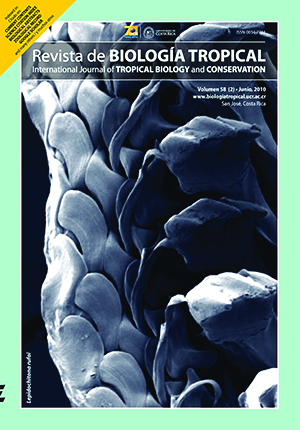Abstract
We present a review of the biological systematic research in Latin America during the twentieth century, applying a bibliometric analysis to the information contained in international databases with the largest number of biological records: Biosis (since 1969), CAB (since 1910) and Science Citation Index (since 1900), to recognize certain patterns and trends regarding the document production. We obtained 19 079 documents and 1 387 journals for Biosis, 14326 and 2537 for CAB, 3257 and 1636 for SCI. Of the documents, 54.6% related to new species, 15.3% dealt with morphology, 14.9% keys, 12.5% descriptions, 10.6% cases of synonymies, 6% new genera, 4.9% new geographical records, 23.6% geographical distribution, 4.2% redescrip-tions, and 3.6% with new nomenclatural combinations. The regions mentioned were South America with 11.9%, Central America with 4% and America (all) with 2.56%. Nineteen Latin American countries appear, whereas outside this region we found the United States of America with 12.6% of representation and Canada with 3%. Animals (65.6%) were the most studied taxa, which was 1.7 times higher than what was published for plants (37%), 11 times higher than fungi (6%) and nearly 30 times higher than microorganisms (2.3%). Out of the 155 journals that produced 66% of the papers, 76.5% were better represented in Biosis, 21.4% in CAB and 2% in SCI. Twenty-nine journals published 33% of the articles, the maximum number of records obtained was 69% for Biosis, CAB 24% and 6.9% for SCI, three (10.3%) are in biology, 11 (37.9%) in botany, 13 (44.8%) zoology, and two (6.9%) paleontology; eight of these journals (27.5%) were published in Latin America and twenty were indexed in the Science Citation Index. In the last two years more journals of the region that publish on taxonomy have been indexed, but their impact factor is still low. However, the impact factor of a number of Latin American journals that published biodiversity increased with time. Countries that are more interested in studying the Latin American biota from the taxonomic point of view are Brazil, the United States, Argentina and Mexico. The most active institutions in this discipline were the Universidade de São Paulo, Universidad Nacional Autónoma de México, and the Universidade Federal do Rio de Janeiro; together they produced 24% of the documents.
##plugins.facebook.comentarios##

This work is licensed under a Creative Commons Attribution 4.0 International License.
Copyright (c) 2010 Revista de Biología Tropical






